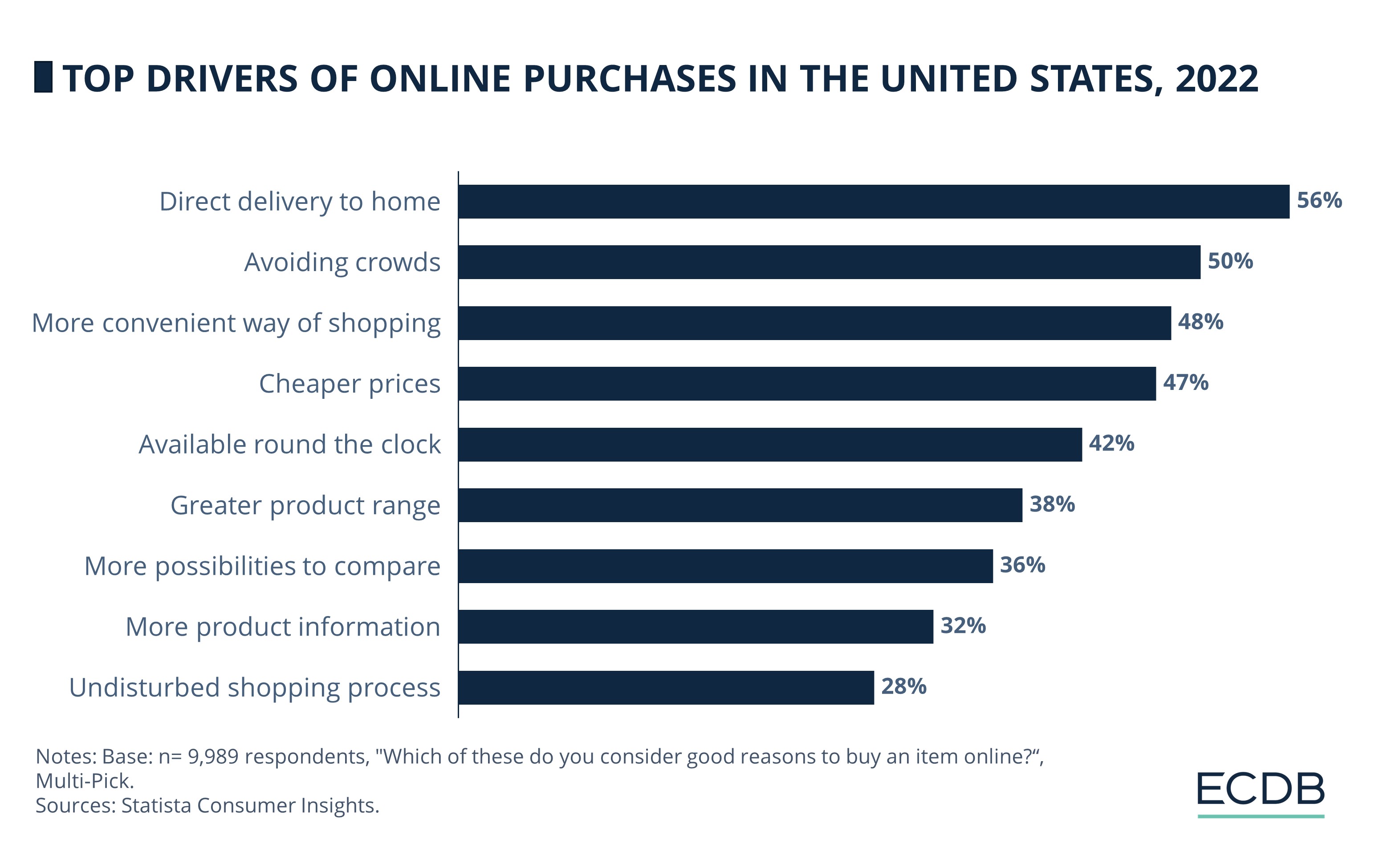eCommerce in the U.S.: Consumer Insights
U.S. Consumer Shopping Attitudes 2023: Drivers of Online Spendings
Online shopping has become an increasingly common part of our daily lives, especially in recent years. What is it that makes spending money at online retailers so attractive?
April 04, 2024
U.S. Consumer Shopping Attitudes 2023:
Key Insights
Consumer Preferences: Americans prefer online shopping, spending US$381 per product on average, driven by convenience and variety.
Online Shopping Favored: U.S. consumers show a strong preference for online shopping, with 43% preferring it over in-store purchases, spending 54% of their budget online, driven by factors like convenience and quick delivery expectations.
Key Motivations for Online Shopping: Drivers for online purchases in the U.S. include avoiding crowds, convenience, cheaper prices, 24/7 availability, and a wider product range, shaping evolving consumer preferences.
Future Retail Landscape: In the future, offline and online retail may merge, with concepts such as showrooming and webrooming becoming more common.
The United States is the world's second largest eCommerce market in the 2023 ECDB country ranking, with revenues of US$981.2 billion. This represents an increase of 6.8% from 2022. Until 2028, the market is forecasted to achieve US$1.4 trillion.
Not only does the country have a strong presence in the eCommerce market, but it also has consumers who are eager to spend money online. According to an extensive report by Wunderman Thompson Commerce, shoppers in the United States are ready to spend US$381 for a single product, which is above the survey average. This puts them in eighth place overall out of 18 selected countries.
But what drives consumers to spend money online?
Why Do U.S. Consumers Prefer
Online Shopping?
Online shopping has become a major part of how people in the United States buy things. In 2023, surveys from Klarna and Nepa showed that 43% of people in the U.S. would rather shop online than go to a store, with only 27% preferring to shop in-store. This makes the U.S. the country most inclined to shop online among those surveyed.
The "Future Shopper Report 2023" noted that over half of the money spent by U.S. consumers, 54% to be exact, goes to online purchases. This trend isn't slowing down. It's expected to grow, with online spending in the U.S. projected to hit 59% by 2033, while the global figure could reach 64%.
So, what drives Americans to click 'buy' on their screens rather than head to the store? The main reason, highlighted by 56% of people according to Statista Consumer Insights, is the convenience of having items delivered directly to their homes.

Another important factor is speed: 30% of shoppers expect their purchases to be delivered in less than two hours. When thinking about why they choose online shopping, 50% of consumers say it's to avoid crowds, 48% find it more convenient, and 47% believe it offers cheaper prices. Other significant advantages include shopping any time they want (41%) and having access to a wider variety of products (38%).
What Influences Online
Shopping Decisions?
When diving deeper into what influences people's decision to shop online, there's a clear preference for the ability to compare different products and find more detailed information about them. Around 36% of consumers value the ability to compare items easily, and 32% appreciate having access to extensive product information.
These factors are particularly important to older shoppers, who often use the internet to research products before making a purchase. Indeed, nearly half of online retail consumers start their shopping journey with a web search.
Despite the popularity of online shopping, a small percentage of people remain unconvinced. Only 5% think “There are no good reasons to buy items online”, while 3% “Don’t know” and 4% picked “Other”. The survey presents arguments, explaining why online spending continues to rise even after the COVID-19 pandemic.
U.S. Consumer Shopping
Attitudes 2023: Closing Thoughts
To conclude, it is evident that many of the factors driving online shopping, such as “Avoiding crowds” or “Undisturbed shopping process” as well as 24/7 availability, are often not feasible for a brick-and-mortar retailer. This makes the online retailer more attractive and drives the trend toward online shopping.
Offline retailers will not disappear from our daily lives any time soon. It is much more likely that offline and online shopping will merge, and shopping trends such as showrooming or webrooming will become more common.
Related insights
Article
eCommerce in India: How Young Consumers Like to Shop and Engage Online
eCommerce in India: How Young Consumers Like to Shop and Engage Online
Article
Gen Alpha: The New Consumer
Gen Alpha: The New Consumer
Article
Augmented Reality in eCommerce: Consumer Preferences and Use Cases of IKEA, Sephora, Walmart
Augmented Reality in eCommerce: Consumer Preferences and Use Cases of IKEA, Sephora, Walmart
Article
Live Commerce Trends in China: Market to Exceed US$1 Trillion by 2026
Live Commerce Trends in China: Market to Exceed US$1 Trillion by 2026
Article
Conversion Funnel: How to Increase Your Conversion Rate
Conversion Funnel: How to Increase Your Conversion Rate
Back to main topics